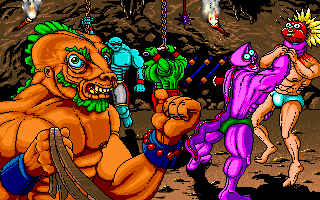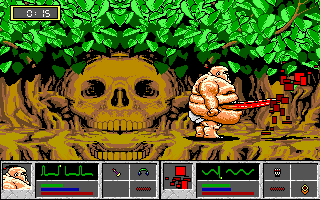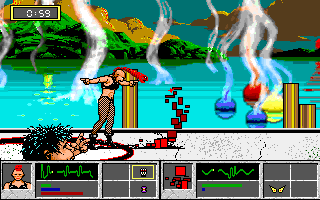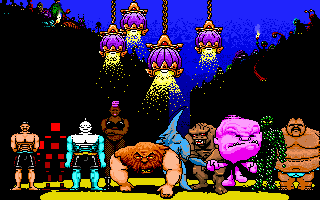Tongue of the Fatman
Game Review
Game: Tongue of the Fatman
Rating: B
Released in 1989 for IBM and compatible computers (and later ported to the Commodore 64 and SEGA Genesis), Tongue of the Fatman is a unique and odd game. A one on one fighting game, few titles of this variety existed for the PC at the time and, in my opinion, it wouldn't be until years later when the genre was refined enough to make some truly solid games (e.g. SoulCalibur). I am not exactly a fighting game aficionado so keep that in mind if you are; however I always thought this was actually an original and fun title a little ahead of it's time; as I prepared to write this brief review and I was doing a few Google searches, I was surprised to find how many reviews out there more or less rate this among the worst of the worst; ouch! It's definitely not a perfect game and does have flaws, but at least a few of these are simply due to limitations of when the game was released and/or limitations of the technology of the time; a few others come down to personal taste and your tolerance for weird. Whatever flaws you may find (legitimate or not), I think this game is definitely worth checking out and highly underrated.
So now it's time for another rambling, stream of consciousness review! But first, the game concept; as a newbie fighter in the Fight Pits run by Mondu the Fat, your goal is to defeat 10 different alien fighters (including the titular fatman) to become the champion. When first starting the game, there are only 3 fighters available; once players succeed at reaching and defeating the fourth fighter and all those after, that fighter will then be available for players to select. Regardless of which fighter is chosen, to win all 10 fighters in the game need to be defeated. Prior to each fight, players can place bets on the fight; winning earns money, and if players win within the time limit wagered even more money is won. Additionally, Doctor Kadaver sells weapons players can purchase to “cheat” during the fight. Up to four can be carried for each fight and while, strictly speaking, they are not necessary to win, purchasing appropriate weapons can make the game a lot easier. Weapons cost money, so making risky wagers for each fight that allow purchase of more powerful weapons is typically desireable. Players have at most three losses (or if players lose a fight and doesn't have enough money to be revived) and then the game is over.

The game did live up to some expectations, and fell short in a few areas, but as noted I thought overall the results were both creative and fun. On the plus side, it was weird; perfect! If the unusual title wasn't enough to give that away, even the instruction manual is written in an alien point of view that introduces you to the Fight Palace concept (including baseball-style fighter trading cards printed throughout which doubles as a form of copy protection). The graphics are not too bad; originally designed for 256 color MCGA/VGA, the artwork is colorful, silly, grotesque, and more or less appropriate. A few unessential details add to the atmosphere with cheering alien heads popping up from time to time to the green alien woman holding a sign when you win. If you didn't have an MCGA or VGA system available, the EGA and Tandy graphics are also decent and clear enough to enjoy the game (only the CGA graphics are an issue. With the limited color palette, the fighters and backgrounds can blend together too much). Gameplay wise, as you're fighting there are three different bars representing damage, crowd favor, and attack effectiveness. This provides some nice strategy as if you keep reusing a powerful attack, eventually your opponent is able to predict it or the crowd becomes bored and the attack slowly becomes useless; so mixing up attacks is absolutely necessary. Each fighter could perform 15 different basic moves (kick, punch, jump, etc.) which while typical certainly wasn't bad for the era. Each fighter also had a unique special attack with wackiness and offensiveness at the forefront; also seems very appropriate for the game's concept and was unusual enough to set the game apart. The weapons available are also varied; some are useless to you as a player but work well for the computer while others are quite powerful. Not all of the are affordable from the start, so it makes risky bets tempting to acquire the more exotic and powerful options! It's all some nice variety for a fighting game providing a downright decent amount of depth and variety that holds up well today.

On the mixed/neutral side is the music and sound; it's not bad, but I wouldn't put it in my list of impressive musical themes either. No matter what synthesizer you're using, the game sounds used pretty straightforward and don't really push the technology to the limit as some games did. Not really a huge flaw, but it also doesn't impress either. Regardless of instrumentation, the music itself is average at best. 1980's synthesizer limitations could certainly be forgiven if you had an amazing composition, but that's not the case here; all we have is average video game music. The Roland MT-32 option by far provides the best sound quality, of course, and probably is what the music and sounds were composed for which is not unusual for the time. If you have any of the other supported sound hardware (AdLib, Tandy, PC Speaker), the results are not out of line for that configuration. For whatever reason Activision seemed to not have perfected their sound support in this era or at least didn't put enough effort into it to do anything more than something minimal. This isn't the only game where they had wacky, buggy, or otherwise limited sound support; from the era Ghostbusters II comes to mind as having similarly buggy support and Die Hard didn't even support sound cards although released around the same time. For Fatman, the biggest limitation is the necessity to choose between music or sound effects during the fights; you can't have both at the same time for some reason. If you're limited to only the PC Speaker maybe this might make sense, but any of the supported sound cards could play both sounds and music together just fine, and this would have been a really nice option. On a more or less plus side, it's also worthy to note the limited Sound Blaster support; the game is among the first to utilize the card's DAC. This isn't mentioned anywhere (including in the setup program), but it's there! If you have the card on it's default settings, it's automatically detected and utilized for a few sound effects (including "Mondu welcomes you to the fight palace!" in the beginning). Pretty cool at the time, really; the problem is if you don't have your card on the default IRQ and DMA settings, you wouldn't even know you were missing something and if you did there's no way to reconfigure the game. While the inability to reconfigure Sound Blaster card settings wasn't unusual, it gave the game a low budget feel; higher quality games all let you choose how your Sound Blaster card was installed. As an early game to support the card, maybe that could be forgiven? But even at the time I didn't think so as Creative Labs documentation seemed pretty clear that changing the IRQ and DMA settings was not only possible but likely depending on the hardware you had — even then to assume no users would do this just seems rediculous.

On the negative gameplay side, balance seems to be the biggest problem. The abilities between the different fighters neither even out nicely or have any kind of strategic differences where careful selection helps. This leads to progression through the game feeling uneven; as you unlock new characters, they don't necessarily allow you to progress further more easily, they are just a new character. I actually found Rubic, one of the first three characters you have to be one of the easiest to win with. His special move has him collapse into a box and expand again to his multi-box form; if you're close enough to an opponent, it does quite a bit of damage! And when you do finally reach (and defeat) the fatman, there's not much sense of accomplishment any different than at any other point during the game; he ends up being just another fighter and doesn't feel like you just defeated the ultimate boss of the fight pits! And once you can select the fatman as a character, he really doesn't seem that powerful; not bad, but his special moves and abilities don't give you a an advantage that seems too much different than other fighters. The weapons available are varied and crazy which is a nice touch; some are useless, some very powerful. However, the cost associated with each one doesn't exactly match how useful something is; I found both cheap and expensive ones to help me out the best and as I acquired more money that didn't always equate with being able to buy something more handy. As you had a large variety of attack moves available, the controls were a bit cumbersome; various key or joystick combintations were needed depending on the attack you wanted. I can't really call this a negative; I always found this a difficulty with fighting games, but it's also the nature of the beast. Mortal Kombat, by far a classic of the genre, does something similar that I also never mastered. I don't think my inability to fully get a grasp of the controls well should be considered a huge negative, as I have that problem with all fighting games it seems. Since I'm all around not good at that, I'm going to say the controls are typical for the genre; at the time the game came out, they may have even been more complicated than average, I'm not entirely sure. I've read people found the controls unresponsive; I thought that was only kinda true; a lot of the attacks in the game don't happen exactly the second you press a joystick button or similar; your character has to move into position or something similar, so successfully executing the attack requires some careful timing. I never thought that to be unresponsive per se, it's just part of the strategy the game demands. On the other hand, it also feels like it causes problems too; you can get caught in a corner where your opponent keeps attacking before you even have the time to move out of the way or execute a move yourself. It's possible to win the same way as well, where with a little luck and timing even supposedly powerful characters like the fatman can be taken out in mere seconds. At times it seemed like this was the only way I could win; if I didn't get my opponent knocked down quickly, sometimes I couldn't at all.
A few criticisms I found I just don't particularly agree with or I'm confused by; apparently the fatman was ranked #3 on the list of “Unsexiest Sexy Video Game Characters”, so OK I guess? He's not really supposed to be sexy, it's an alien fighting game! Do sexy characters make the game any better or worse? ...is this a negative, or a compliment? It seemed like this was intended to be a negative, but I disagree; the over the top offensive characters in Fatman are a plus and only add to the game. It's also been rated amongst the weirdest games of all time, which is probably true. Again, however, I think is a good thing, and puts the game in an original and creative category. The original PC version box cover has also been criticized which I don't understand why, as I found it to be an incredibly clever and original design that stood out compared with other games on the shelf. Combined with the unusual game title, it immediately made the game noticable and made it feel outside of the bland or norms. It's all very weird, but then I find that to be a bonus. The game is from an era when designers were trying new things, some worked and some didn't, and this game didn't feel the need to fit any existing predefined mold. If only wacky and bold chances were taken more often! If you're into fighting games, there are probably some more influential games I forgot to mention, or maybe a few I haven't even played yet. But as an outsider to the genre, this one was great fun; it wasn't until Mortal Kombat and SoulCalibur came along a few to several years later that something better appeared.

If I had to suggest improvements I would have most liked to see, it would be to have the unlocked characters actually provide some advantage to progressing through the game; they really didn't, what they offered was cosmetic variations on special attacks. Some real incentive to have a new character unlocked other than a new attack that provided more than a variation on a theme would have been nice. Getting the balance a little better where it's not possible to lose or win fights so quickly would be the other desired improvement. But still, at the end of the day, I'm going to rate the game B despite the several weaknesses. I really had a lot of fun with it when it was initially released, and while imperfect it is very creative, quirky, and perhaps just a bit ahead of its time. The variations offered by the various fighters and the various weapons is impressive and made for a unique experience. This review is based on the PC version; the Commodore 64 version is similar but a bit more limited (well, a lot more...) and the Genesis version is different enough to nearly seem like a different game with new graphics, sounds, and improved gameplay. I haven't played those versions in a long time, and if you're trying one of them out, the overall gameplay is the same but some of the strengths and criticisms of the PC version will vary. If you try the PC version, don't forget to install from the 5.25" disk set or you'll miss a few extra graphics and sounds!